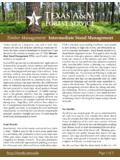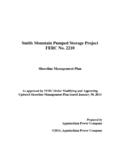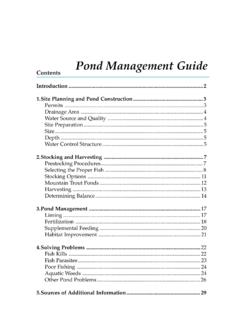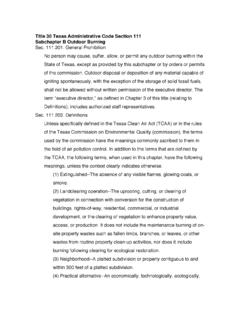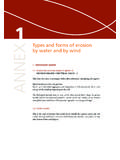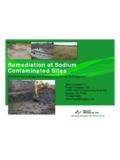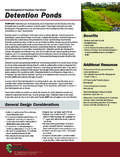Transcription of Calculation of the number of kangaroos to cull.
1 Calculation of the number of kangaroos to cull . INTRODUCTION Since 2009, the ACT Government has conducted an annual cull of eastern grey kangaroos in selected nature conservation areas to prevent over-abundant populations from impacting on endangered ecological communities as a result of over grazing. All policies for kangaroo management in the ACT, including this conservation culling, are explained in the ACT Kangaroo Management Plan (KMP). This note uses non-technical language to explain one aspect of how the policy is being put into practice at present.
2 It explains how the policy for conservation culling is translated into numbers of kangaroos to be culled. Repeated reference is made to the KMP, which is unusual among policy documents for the extent of explanation it provides and the number of references it gives to the scientific literature. Thus, readers with a particular interest in the issue are encouraged to start by consulting the KMP. It is available from by searching for kangaroos . Illustrated, user-friendly guides to other kangaroo policy issues can also be found there. The purpose of conservation culling of kangaroos in ACT reserves is to maintain grassland conservation densities of kangaroos (defined on p 106 of the KMP).
3 In particular the aim is to achieve a grazing regime favourable for the conservation of small animals that depend on the ground-layer vegetation. The phrase animals that depend on is used deliberately to include species such as some birds that depend on ground layer vegetation without necessarily being regarded as living in it. In meeting this aim, it is expected that the conservation requirements for plant biodiversity will also be met. This is not treating kangaroos as pests Grazing is important to the conservation of grassy ecosystems, and eastern grey kangaroos are regarded as being central to the healthy functioning of these ecosystems.
4 Thus the Calculation of the number to cull begins with the Calculation of the number of kangaroos that need to be retained in the reserve. Under no circumstances are all, or nearly all kangaroos in a reserve intended to be culled, as explained below. Nor is there any plan for culling in the majority of the ACT. Culling is being conducted in a minority of the 39 urban nature conservation areas (including 34 nature reserves and 5 planned nature reserves). Damage reduction? Most of the culling is no longer reacting to existing damage. As much as possible the culling is being managed as a preventative program.
5 By culling a small population annually, rather than delaying for years, or reacting to damage, fewer animals are culled over the long term, and environmental damage can be avoided. Conservation requirements and ecological context Within the lowlands of the ACT are remnants of ecological communities listed nationally as endangered. The remaining areas of land supporting lowland natural temperate grassland and yellow-box red-gum woodland are now only fragments of the natural extent of the grassy ecosystems. The main threat to these communities has been agricultural and urban development associated with human population growth.
6 It is a high priority to conserve and manage well the remaining fragments. The environment of these endangered ecological communities has been changed in important ways, including by the removal of large predators such as Thylacines and dingoes. Hunting by Aborigines and early Europeans has also been suppressed. In the absence of top predators, in the temperate climatic zone, large herbivores like deer and eastern grey kangaroos can increase in abundance to the point that they maintain the ground layer vegetation in an eaten down condition. The ground layer vegetation may also be the home of small animals such as insects, frogs, reptiles, and birds.
7 In some places these include 2 threatened species such as grassland earless dragons, striped legless lizards, and hooded robins. When eaten down, the grassy ecosystems no longer provide food (such as plentiful insects) for these animals, nor shelter from their predators (such as native birds of prey). This can lead to a decline in their populations and localised extinction. To protect the populations of small animals and the health of the ecosystem, kangaroo grazing needs to be kept at moderate levels (Figure 1). In this sense the culling is filling the role of the missing predators.
8 Figure 1: The aim of the conservation culling policy is to moderate grazing pressure and reduce the risk of biodiversity losses due to either undergrazing or overgrazing. Access to scientifically based evidence The ACT Government has access to reports from kangaroo research carried out all over Australia, and has made a significant contribution itself through the local research it has supported. This has included the first population dynamics study of the eastern grey kangaroo species, and the first for any kangaroo in a temperate environment. Research has also been conducted on kangaroo movement behaviour, fertility control, fecundity, and body condition.
9 Research partners have documented the conservation effects of kangaroo grazing. A substantial body of knowledge is now available on which kangaroo management decisions can be based. Chapter 3 of the KMP deals with kangaroo ecology generally and Chapter 5 identifies conservation impacts. Research that demonstrates kangaroo impacts in the ACT has been available for many years (for birds Neave and Tanton 1989). After the KMP was published, the results of other scientific investigations of kangaroo grazing and biodiversity have begun to become more accessible (McIntyre et al.)
10 2010, Barton et al. 2011; Diamond et al. 2012, Manning et al. 2012) and there are ongoing PhD research projects not yet complete. Taken together, these studies verify that the effects on biodiversity of heavy grazing by kangaroos are at least as great as they appeared to be when the KMP was written. Can a native species have an impact on other native species? It is sometimes claimed that kangaroos , being a native species, could do no harm to another native species. Section (p 51) of the KMP gives examples to the contrary, of native species having detrimental conservation effects.

